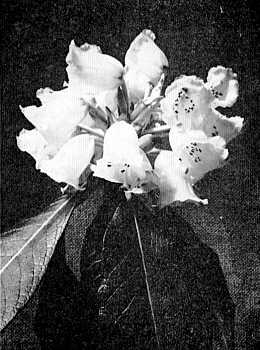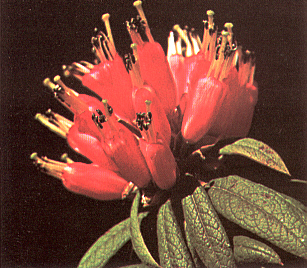My Six Favorite Rhododendron Species
A. W. Headlam, Bentleight, Australia
I have often pondered the question of which I would choose for my six favorite rhododendron species, and for number one place, I invariably come back to
R. augustinii
.
My first introduction to this species was on a sunny spring afternoon at the Linden Gardens, Mt. Dandenong. Standing in front of the house, it made a charming picture, a complete change in color from most other rhododendrons. The large flowers of pale lavender blue have a yellowish green blotch on the upper lobe, and the light red stamens protrude from the corollas - it has an indescribable beauty and blends tastefully with the surroundings against a background of eucalypts and acacias and the delicate pale green leaves of the oaks, elms, and many other deciduous trees whose new leaves are just appearing.
This particular plant, as does most of this species, can vary in intensity of color from season to season as well as under different lighting conditions, the pink shades being accentuated in bright sunshine, and the blues come into their own when the sun goes under a cloud, or the plant is shaded by the tall trees in the garden.
After a sharp shower of rain the branches arch and the droplets of water glisten in the pleasant spring sunshine, nevertheless it is to me a very exasperating rhododendron, photographically. The color as with all flowers in the lavender blue tonings, tend to photograph as pink for reasons involving the reflectance characteristics of the flowers and sensitivity of color films. Whilst this problem can, to some degree, be overcome by the use of pale blue filters, or photographing the flowers under cloudy conditions, there is really no practical solution to the problem, so one must be content to rely upon ones memory of this most attractive species in the Triflorum Series.
Number two choice presents no problem; it is taken by a rhododendron which grows to perfection in the Dandenong Ranges,
R. nuttallii
, s. Maddenii, s.s. Megacalyx.
A well grown plant with its large dark green bullate foliage carrying trusses of six and seven creamy white perfumed flowers, with a yellow blotch in the throat, is a sight not easily forgotten, and a source of admiration to visitors from the northern hemisphere, where rhododendrons in the Maddenii series and sub-series are, due to the colder climatic conditions prevailing, almost invariably greenhouse plants. A spectacular sight is the group planting of
R. nuttalli
in the Australian Rhododendron Society's National Rhododendron Garden at Olinda.

|
|
FIG. 92
. R. falconeri
Headlam photo |
Next on my list comes
R. falconeri
, Series Falconeri. There are some fine specimens of this rhododendron in several of the older established gardens in the Dondenongs where one may see trees up to twelve feet in height with a spread of some fifteen feet.
The large dark green leaves with a deep rust colored indumentum and the new shoots with a fawn tomentum are, in themselves of sufficient beauty to warrant a place in any garden. For this fine species, another attraction is the reddish brown flaking bark, which may be overlooked unless one takes a close look under the canopy of leaves.
As spring progresses, the large buds expand and eventually open to display trusses carrying up to twenty-five pale yellow florets with a purple blotch - at this time one can agree with the many superlatives used to describe this magnificent rhododendron.
R. orbiculare
, s. Fortunei, s.s. Orbiculare, comes next on my list, having earned its place for its attractive well rounded habit of growth, its broadly ovate leaves, bright green above and glaucous below, and finally its attractive flowers gracefully carried in loose trusses of from seven to ten rose pink florets. This is a rhododendron which is most rewarding when planted as a lawn specimen to permit full appreciation of its circular habit of growth, a focal point of attraction even when not in flower.
R. ciliicalyx
, s. Maddenii, s.s. Ciliicalyx, is the next species on my list; whilst this rhododendron is often quite straggly in habit of growth, some judicious pruning in its early stages can, in some measure, overcome this characteristic, however, when a plant is seen in full bloom, one easily forgives the straggly habit of growth. The attractive large white funnel shaped flowers in clusters of seven to ten are sometimes suffused with pale rose.
I personally have a predilection for the flowers suffused with the pale rose markings, which color is particularly attractive and more prominent in the bud stage, and when the florets are just about to open.

|
|
R. spinuliferum
Photo by A. W. Headlam |
Now I have only one space left, and this is the most difficult choice of all as I have at least half a dozen species which I would like to include, however, decisions must be made, and after considerable deliberation I have chosen for my final place,
R. spinuliferum
, s. Scabrifolium, an erect growing shrub whose softly pubescent branches carry leaves up to three inches in length, bullate above and reticulate below.
The crimson to orange-red flowers produced in clusters towards the apex of the shoots, about one inch in length, are narrow and tubular, and the style and stamens just have room to protrude from the crimped end of the tube.
Its attraction lies in the way the flowers are produced in groups of five or six, standing upright in almost mathematical precision, and the fact that it is quite different from any other rhododendron, so different that many people at first sight, find it difficult to believe that it is in fact a rhododendron at all.
R. spinuliferum
, which was discovered in the Yunnan Province of China by Delavay, was named for the bristly hairs covering the young shoots and extending to the undersurfaces and margins of the leaves.
So much for my choice, which may or may not appeal to readers. I have perhaps been fortunate that my writing on the subject of rhododendrons has taken me into many fine gardens in the Dandenong Ranges, the home of rhododendrons in Australia. On the other hand, with the wealth of material to choose from, narrowing the field down to a mere six has made the final choice even more difficult.